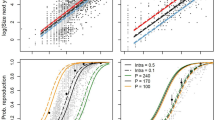Abstract
Theoretically, temporal variation of reproduction promotes species coexistence of sessile and polycarpic organisms when the reproduction is synchronized within species but independent among species. Monopoly of vacant sites and high relative population growth rate of minor species in the absence of propagules of other species is the essence of this mechanism. The mechanism is expected to work in forests, but persistent populations of seedlings may affect the promotion of coexistence. Using a tree-based simulation model of forest dynamics, it was demonstrated that the number of coexisting tree species was sensitively affected by the seedling establishment rate. The coexistence was not enhanced by temporal variation of reproduction when seedling establishment rate was low. This is because the reproducing minor species fail to monopolize vacant sites and allow the establishment of seedlings of other species in later years. High mortality of established seedlings under shade also suppressed coexistence. This is likely to be the result of a reduced storage effect of the population of seedlings. A forest structure and dynamics pattern that appears when tree species coexistence is promoted by fluctuating reproduction was searched for, and the number of coexisting species was varied by manipulating the seedling establishment rate. No distinct difference other than the species number itself was found between species-rich and species-poor forests. For example, the seedling population size varied, reflecting the temporal variation of reproduction, irrespective of the seedling establishment rate. Further strategy development is needed to validate the proposed mechanisms of species coexistence.








Similar content being viewed by others

References
Botkin DB, Janak JF, Wallis JR (1972) Some ecological consequences of a computer model of forest growth. J Ecol 60:849–872
Chave J, Muller-Landau HC, Levin SA (2002) Comparing classical community models: theoretical consequences for patterns of diversity. Am Nat 159:1–23
Chesson P (2000) Mechanisms of maintenance of species diversity. Annu Rev Ecol Syst 31:343–366
Chesson PL, Warner RR (1981) Environmental variability promotes coexistence in lottery competitive systems. Am Nat 117:923–943
Condit R, Hubbell SP, Lafrankie JV, Sukumar R, Manokaran N, Foster RB, Ashton PS (1996) Species-area and species-individual relationships for tropical trees: a comparison of three 50-ha plots. J Ecol 84:549–562
Connell JH (1978) Diversity in tropical rain forests and coral reefs. Science 199:1302–1310
Duchesneau R, Morin H (1999) Early seedling demography in balsam fir seedling banks. Can J For Res 29:1502–1509
Grimm V, Railsback SF (2005) Individual-based modeling and ecology. Princeton University Press, Princeton, NJ
Grubb PJ (1977) The maintenance of species-richness in plant communities: the importance of the regeneration niche. Biol Rev 52:107–145
Herrera CM, Jordano P, Guitián J, Traveset A (1998) Annual variability in seed production by woody plants and the masting concept: reassessment of principles and relationship to pollination and seed dispersal. Am Nat 152:576–594
Higgins SI, Pickett STA, Bond WJ (2000) Predicting extinction risks for plants: environmental stochasticity can save declining populations. Trends Ecol Evol 15:516–520
Hubbell SP (2001) The unified neutral theory of biodiversity and biogeography. Princeton University Press, Princeton, NJ
Hurtt GC, Pacala SW (1995) The consequences of recruitment limitation: Reconciling chance, history and competitive differences between plants. J Theor Biol 176:1–12
Janzen DH (1970) Herbivores and the number of tree species in tropical forests. Am Nat 104:501–528
Kelly D (1994) The evolutionary ecology of mast seeding. Trends Ecol Evol 9:465–470
Kelly CK, Bowler MG (2002) Coexistence and relative abundance in forest trees. Nature 417:437–440
Kohyama T (1984) Regeneration and coexistence of two Abies species dominating subalpine forests in central Japan. Oecologia 62:156–161
Levins R (1979) Coexistence in a variable environment. Am Nat 114:765–783
McGill BJ (2003) TL: a test of the unified neutral theory of biodiversity. Nature 422:881–885
Nakashizuka T (2001) Species coexistence in temperate, mixed deciduous forests. Trends Ecol Evol 16:205–210
Pacala SW, Canham CD, Saponara J (1996) Forest models defined by field measurements: estimation, error analysis and dynamics. Ecol Monogr 66:1–43
Shibata M, Nakashizuka T (1995) Seed and seedling demography of four co-occurring Carpinus species in a temperate deciduous forest. Ecology 76:1099–1108
Shibata M, Tanaka H, Iida S, Abe S, Masaki T, Niiyama K, Nakashizuka T (2002) Synchronized annual seed production by 16 principal tree species in a temperate deciduous forest, Japan. Ecology 83:1727–1742
Takenaka A (2005) Local coexistence of tree species and the dynamics of global distribution pattern along environmental gradient: a simulation study. Ecol Res 20:297–304
Tilman D (1994) Competition and biodiversity in spatially structured habitats. Ecology 75:2–16
Tilman D (1999) Diversity by default. Science 283:495–496
Warner RR, Chesson P (1985) Coexistence mediated by recruitment fluctuations: a field guide to the storage effect. Am Nat 125:769–787
Whitmore TC (1984) Tropical rain forests of the far east. Clarendon Press, Oxford
Wilson MF (1993) Dispersal mode, seed shadows, and colonization patterns. Vegetatio 107/108:261–280
Wootton JT (2005) Field parameterization and experimental test of the neutral theory of biodiversity. Nature 433:309–312
Wright SJ (2002) Plant diversity in tropical forests: a review of mechanisms of species coexistence. Oecologia 130:1–14
Zhang DY, Lin K (1997) The effects of competitive asymmetry on the rate of competitive displacement: How robust is Hubbell’s community drift model? J Theor Biol 188:361–367
Acknowledgement
I thank Dr. F. Ishihama at the National Institute for Environmental Studies for critical comments on the manuscript.
Author information
Authors and Affiliations
Corresponding author
About this article
Cite this article
Takenaka, A. Dynamics of seedling populations and tree species coexistence in a forest: a simulation study. Ecol Res 21, 356–363 (2006). https://doi.org/10.1007/s11284-006-0165-y
Received:
Accepted:
Published:
Issue Date:
DOI: https://doi.org/10.1007/s11284-006-0165-y



